

|
Back to |
| The Front Page |
| News & Features |

|
"Through the Hoops" spells out winning tactics for Golf Croquet |
||||||
|
Book chapter by Greg Bury Photos and illustration by Andy Hallinan Posted July 18, 2011
|
||||||
|
||||||
Golf Croquet has become an important element of the sport's global development since the early 90's. Its increasingly significance can be weighed by Golf Croquet's frequent appearance in local club calendars throughout the world, not just for introductory programs, but also for tournaments - competitive events attracting top-ranked Association Croquet players. The game is easy to learn and easy to watch. Some say it's easy to play, but until now, there has been no authoritative published guide for success in competition. The inevitable has now happened, in Australia, with Greg Bury's new book, financed by Queensland's state government. A first printing of 500 copies quickly sold out, with all the profits going to the Queensland Croquet Association. Here's a critical chapter.
| CONTENTS OF "THROUGH THE HOOPS" |
|
Introduction p4 |
Players sometimes underestimate or overestimate their opponents and may take unnecessary risks.
Focus on your own performance, the reasons you are there, and what you want out of the day. If you didnít perform to your expectations, learn from your experiences and try to improve on specific elements of your game. It doesnít matter who you play, there will always be four balls, six hoops and an opponent.
If you didnít perform to your expectations learn from your experiences and endeavour to improve on specific things.
By analysing your game you may find you need to focus more on
1. Getting rid of distracting thoughts
2. Concentration levels during a game
3. Use some relaxing techniques during the game
4. Physical fitness, energy levels
5. Skill levels with particular shots
When preparing for your next event ensure you learn and do what you can to prevent the same things happening again.
Not winning is not failure, it is only one small measure of success. If you played well and were beaten by a better opponent then they deserve victory. However if you gained more experience, played to the best of your ability, learned more skills and enjoyed the moment; YOU are the winner.
Losers allow the past to dictate the future.
Winners focus on the present and make the most of their opportunities.
Taking risks
You are 4 points behind, time is running out and opportunities are few and far between yes - it is time to take some risks. You are 2 points in front, time is running out and opportunities are few and far between - why would you take a risk?
What is a risk?
A risk is calculating the chance you have of making a specific shot. For example, if you can make four yard hoops consistently, at say eight times out of ten, then you would say it is a 'percentage shot'. However, if you could only make this shot three times out of ten, then it is called a 'risk shot'. It is important to have an understanding of your own ability and know whether the shot you are taking is a risk shot or a percentage shot. Determining your comfort zone will help you work this out.
Comfort zone
Your 'comfort zone' is the distance where you are most likely to have the most success with your shots. For example, to determine your own comfort zone for hoop running, try this exercise.
Place a marker one mallet head away from the front of the hoop. If you successfully run the hoop three times from this distance, move to a distance of two mallet heads. Repeat the exercise until you reach a distance where you cannot successfully make the hoops three times in a row. This is your comfort zone.
When you are competing, you can use this information to your advantage. If a shot is within your comfort zone, you know that you will have a high percentage of a successful outcome.
Use this information as part of your game plan.
Developing a game plan
Developing a game plan will help you strategise and make good tactical decisions.
When developing your game plan you need to consider:
1. your strengths
2. your confidence level
3. your experience from previous matches
4. tactics for specific circumstances
5. how to manage pressure
6. your comfort zones
7. your routines and the basics of the game
8. your expectations.
Obviously, your game plan is not set in concrete. Use it as a guide, but allow for some flexibility.
Standards
To develop your game, you need to think about where you currently are, your standard, and where you want to be. Your standard is a combination of knowledge, experience, and ability. Your game will move from receiving knowledge to giving knowledge, from making mistakes to preventing mistakes, from taking risks to using percentages, from being nervous to staying calm and relaxed.
For example, a beginner wants to learn from their mistakes, is keen for new information and is generally very motivated. Beginners need to commit to improving their game or be able to rely on natural ability. As a beginner, however, you eventually need to polish and refine you own unique game rather than copying other styles.
Intermediate players have higher expectations for their game, want to do well, and looks for opportunities to improve. At an intermediate level, you need to invest time and show commitment to your game. This may involve taking risks.
Advance players want to play at a very high level. This requires consistency and focus. Advanced players often focus on an aspect of their game and develop a reputation within this aspect, such as a good hoop maker or a good jumper.
Perceptions
Appearing cool, calm, relaxed, and confident sends a strong message to your opponent. Perceptions extend to the way you walk onto the lawn, your posture, your stroke routine, and your attitude.
If you appear to be unsettled, hesitate, or are nervous your opponent may pick up on this, giving them a slight advantage.
In golf croquet if you are on the lawn you can still win the game regardless of the score. Never give up and keep fighting.
Building confidence
The power of positive thinking is sometimes the only difference between two players.
When faced with a challenge, take a deep breath, use positive reinforcement, stick to your routine, visualise a positive outcome, and execute the shot. Believe in your ability.
Another method is to go to your "Happy Place" Ė to imagine somewhere else that makes you feel good. This memory enables you to relax and refocus.
Trigger points
Visualise previous successful shots. You will feel more confident knowing that it is something you have successfully done in the past. Visualise the moment and also hear the sounds of a successful shot such as clapping or the ball making its way through the hoop.
Self-recognition
Donít be too hard on yourself. Become a better player by watching, listening, asking questions, and reviewing your progress. Be flexible, listen to suggestions, and be open to new concepts. Donít become set in your ways. After every game review what went well. If things didnít go as you expected, add more information to your action plan and then act on it. You cannot rely on your opponentís mistakes to win a game.
Did you just win the game or did your opponent loose? The terms snatched victory from the jaws of defeat and take the game by the horns means taking charge of the situation Ė you can not rely upon your opponent to make mistakes.
Making decisions
There are some useful techniques and processes that can help you decide how to choose a shot. Always consider every option before making a decision. Take into consideration factors such as your ability, conditions, your current state of mind, the state of the game, and previous outcomes.
For example:
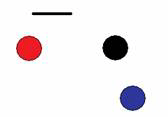
|
1. Run a 4-yard hoop.
2. Try and stick in the jaws of the hoop.
3. Remove Red that is in a better position than Blue.
4. Promote partner ball into a hoop running position.
5. Play a block on red.
Most players just see an open hoop and go for it. Some players would try and stick in the hoop. Some players would take out Red every time. Most players would not think of or attempt option 4. Some players would block without hesitation.
So what is the right decision?
Let's analyse this a little further.
What decisions would you make in the following situations?
You have been running four-yard hoops all day and are feeling confident.
Time is running out and you are two hoops behind.
Time is running out the score is 4-2 in your opponentís favour.
Red is in a good position to jump and the player of Red is a good jumper.
Red is not in a good position to jump.
When you hit Red it will not have a shot on Blue or Black.
It would be an easy shot for Blue to block Red from running the hoop. If Red removed Blue, Black could run the hoop in the next turn.
Blue has failed three hoops in this game from three yards and is not confident.
Blueís stun shots are very good.
Letís go through some rules.
- Look at all options first.
- Never assumeógo and have a look and check positions before you play.
- Use your strengths.
- Use the comfort zone principles.
- What are the percentages?
- Do you need to take a risk?
- Donít show off, or let over-confidence to get in the way.
- If you are patient, will you control this point?
- Am I confident?
- Never underestimate your opponent.
Regardless of whether you go for the hoop or take out the Red, your decision is correct, providing that, once you made up your mind to attack or defend, you focus on making a successful shot.
Good execution always over-rides any tactical decision. The secret is playing to your ability and making rational decisions based on the information you have.
We still havenít considered the position of the yellow ball. If it is at some distance from the hoop, then percentages suggest being patient. Take out the Red ball (preferably wired from Black) and secure the point with a double load. Golf croquet is not a race. However, if you have a very high percentage of success for running hoops from 4 yards out, then this is your strength and you should capitalise on it. Identify your comfort zone.
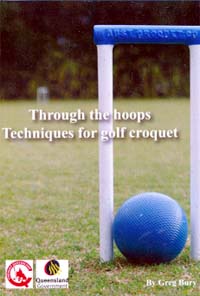
|
TECHNIQUES FOR GOLF
CROQUET
by Greg Bury
(Queensland State Team Representative)
(Sponsored by Department of Sports and Recreation, Queensland)
This is a book written to help you improve your golf croquet. Its content includes topics such as the fundamentals, how to improve, setting goals, how to win, game plans and making decisions.
Tactics for best practice is a section that gives you an opportunity to think about how you would respond to certain situations. Examples are used with solutions given to help you decide what tactic is best suited to your game. Techniques on how to practice is also mentioned in the book, giving players guidelines on how to make practice sessions more rewarding.
Regardless of whether you are a beginner or an experienced player, there is something for everyone.
Donít miss out on your copy! Order today Ė just $17.00, includes postage and packing.

|
Or send your order direct to:
Pam Shepherd, 36 / 242 Parklands Bvd,
Currimundi Q. 4551
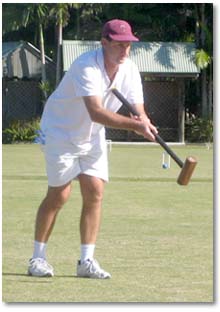
|
Author Greg Bury is 42, lives in Buderim, Queensland, Australia, has been playing croquet for 31 years, and today enjoys the challenge of competing at the highest level. He's former Australian champion in both singles and double, having represented Australia several times in McRobertson Shield, Trans Tasman and World Championship events. Greg is a Member of the Headland/Buderim Croquet Club on the Sunshine Coast. |
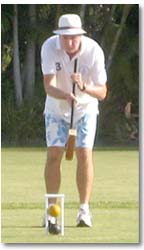
|
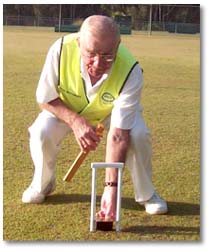
|
| Editor Terry Ericson, a teacher by profession, is well respected in Queensland for the amount of time he spends developing and coaching others, especially in traveling to all parts of Queensland to spread the gospel of Golf Croquet. He's a proud member of the Windsor Croquet Club in Brisbane. | Gordon Matthews helped edit the book. Retired from a medical career, he is now National Director of Refereeing, living in Maroochydore, Queensland, on the Sunshine Coast. Gordon is a valuable member of the Headland/Buderim Croquet Club, especially interested in player development. |

|

|
| Pam Shepherd, Golf Croquet Director for Queensland Croquet and volunteer manager of tournaments and teams, assists in the printing and sales of "Through the Hoops". | Photographer Andy Hallinan lives on the Gold Coast and also produces croquet DVD's. He is former president of the Noosa Croquet Club. His photographs make the book come alive with sharp images and colour. |